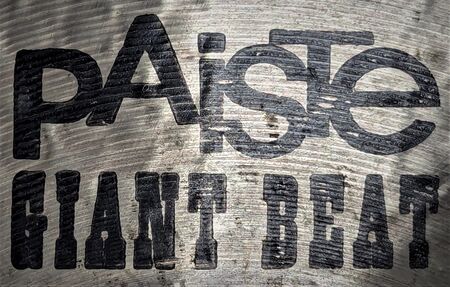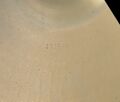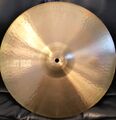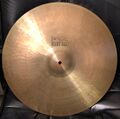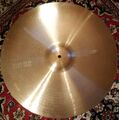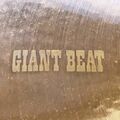Paiste Giant Beat
Giant Beat
Re-Introduction: 2005
Background:
A resurgence in vintage sounding cymbals was the catalyst in their re-introduction in 2005.
We have learned from a 1st. hand account that in the early 2000's there was a custom order placed for a full set of Giant beats by a German drummer who was a Bonham fanatic, at the same time, drummer Steve Jordan was visiting the factory and saw them, he tried and liked them so much he placed a "custom order" set for himself! After several of his drummer friends heard Steve's cymbals, they placed orders as well. It is believed that this new interest in this long discontinued series is what encouraged Paiste to reissue the series!
Innovation: First "fully professional" cymbal series to be manufactured from the popular B8 Bronze, “2002 Bronze” (Stambul65 was considered a mid line cymbal).
Alloy: CuSn8 (Also known as "2002 Bronze")
Quality: Professional
Production: Manual craftsmanship • Hand hammering, hand lathing • Proprietary manufacturing methods
Applications: Soft to loud settings • Live and recording • Rock, Blues, Rock’n’Roll, Swing, Country, Garage Rock, British Rock and Pop, Beat
Users: Working musicians, enthusiasts • Drummers eager to re-capture Paiste vintage cymbal sounds from the late 60’s
Sound: Bright and warm with a multilayered, full, dark, glassily splendid presence.
Multi
Thin
Giant Beat "thins" were added to the line in 2012.
Hi-Hats
Giant Beat vintage

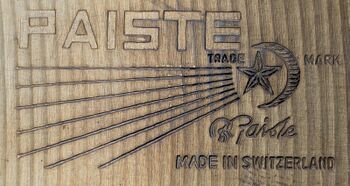
Introduction: 1967
Discontinued: 1974
Background: Robert Paiste had started to experiment with B8 alloy as early as 1963, he was looking for a replacement for the then currently used NS12 (Nickel silver) alloy.
He first produced the "Stambul 65" an upper mid line series that was originally intended to replace the Stambul series (it did not). Because of B8's sound characteristics ( strong midrange, bright high end), he believed this would be the perfect alloy to make cymbals to suit the burgeoning Rock’n’Roll movement and louder amplified music in general.
Innovation: Paiste's first professional level series to be made from B8 bronze.
Alloy: CuSn8 (Also known as "2002 Bronze")
Quality: Professional
Production: Manual craftsmanship • Hand hammering, hand lathing • Proprietary manufacturing methods
Applications: Soft to loud settings • Live and recording • Rock, Blues, Rock’n’Roll, Swing, Country, Garage Rock, British Rock and Pop, Beat
Users: Working musicians, enthusiasts • Drummers eager to re-capture Paiste vintage cymbal sounds from the late 60’s
Sound: Bright and warm with a multilayered, full, dark, glassily splendid presence.
Nick Mason playing a full set of "White label" giant beats
Bonham, Sydney 1972 with his "Black label" Giant beats!
Full set of vintage giant beats
The following description was posted in the Paiste 1969 catalog:
"Continuing their search for new cymbal sounds and tone colors, the Paiste Development have now turned their attention to the problems and requirements of Beat Group and Big Band drummers. As the result of extensive consultations between Paiste Technicians and top line drummers in these fields of music, Giant Beat cymbals were evolved.
The obvious problem of the Beat or Big Band drummer is competing with the sound of the amplifiers or a large number of musicians around him - GIANT BEAT CYMBALS provide the answer!
The production of GIANT BEAT is considerably different to the technique normally employed. Each GIANT BEAT cymbal is passed through a unique hardening process to insure it will stand up to the rigors of continuous heavy playing - this process combined with the way in which the cymbals are shaped, hammered and anodized, finally produces a set of cymbals with a sound capable of cutting through the loudest of Groups or Big Band sections.
Although GIANT BEAT cymbals can be purchased individually, they are offered in tuned sets - Matched 15" Hi-hat, 18" Crash and 20" Ride.
GIANT BEAT cymbals with their distinctive SOUND, SHAPE AND COLORING are fast growing in popularity - try them soon you will be impressed."
The first generation of Giant Beats were printed with semi white ink (white labels) at 9:00 O'clock (see picture gallery below) starting in 1967 until early 1972.
"White labels" are generally considered slightly heavier than their black label successors.
The second generation of Giant beats featured Black ink (at 12:00 O'clock) and a slight change to the way they were stamped.
This series was a concept of multipurpose cymbals. Initially, they consisted of three sizes of cymbals and one size of Hi-Hats (15").
*multipurpose
(From 1972 until early 1974 "black label" versions included 14" Hi-Hats)
Hi-Hats
(*Originally, Paiste did not designate the type of cymbal with the exception of the hi hats (see Paiste profile 1 pictures below), in some advertising they labeled them "crash" or "ride". Ludwig listed the cymbals this way in their catalogs and not as "multipurpose".
(**The 18" was also listed as a "heavy" in Nick Mason's profile and Bonham's endorsement deal, see pictures below)
Serial numbers:
Giant Beats were stamped with serial numbers beginning in early 1972 (the same as the rest of the Paiste lines) through 1974. The numbering system follows the six digit "Swiss standard": first digit of the serial is the year of manufacture i.e. #3xxxxx was made in 1973. As a rule of thumb, if your Giant beat does not have a serial number, it's definitely a white label (pre 1972).
Also, If the printing is worn off your cymbal, there's two ways to tell the age: the emboss or stamp (early or late version, see above) or if it does or does not have a serial number.
If your Giant beat does have a serial number, it's either a very late run white label or a black label, it's safe to say virtually all black labels had serial numbers!
New old stock 1973 serial number black label hi hats
Bonham's use of Giant beats
He was by far the most famous drummer to use these cymbals, it's important to understand when he used them and on what albums and tours.
In an interview with Cozy Powell (they were friends and toured the English club circuit together), he states that in the late 60's both he and Bonham started using Giant beats (both of them had issues with breaking Zildjians, they didn't with Giant beats).
Cozy also states that Bonham was disappointed when Paiste discontinued the line, this may be the reason for the long delay (mid 1973) before he partially switched to 2002's (he still used a Giant beat ride up until 1976).
In a Freddy Studer interview, he states that Bonham had come to the factory in the late 60's (before he had an endorsement deal) and bought some Giant beats and 602's.
When Zeppelin went on tour in the U.S. opening for Vanilla fudge (Dec 1968 through early 1969), Carmine Appice helped him get a Ludwig endorsement, most likely he got a new set of 602's along with his new drumset (Ludwig was the U.S. distributor for 602's at that time). You can clearly see Bonham using all 602's in the March '69 Danish TV performance.
It is generally agreed that Bonham "mixed and matched" 602's and Giant beats until his endorsement deal (see below) in Feb. of 1970.
Photos show that Bonham was using 15" 602 sound edges very early in 1970, he may have switched back and fourth early on between the Giant beat and 602 hi-hats, but after that it looks and sounds like the 602 sound edges were his main hi-hats until the "The song remains the same" U.S. tour in May of 1973 (he then started using all 2002's but kept the 24" Giant beat ride).
Album/tour usage*:
Keep in mind throughout the '70s, Bonham would sometimes use three or even four crashes live, he may have added extra crashes in the studio as well. Below is an educated guess on what Bonham used in the studio based on what he was using live during that period of time and also the sound qualities of the cymbals on the recording.
Led Zeppelin I: Unknown, possibly mixing 602's, Giants beats and Zildjians.
Led Zeppelin II: Most likely a mix of 602's and Giant beats (this was before he had an endorsement deal), this album was mostly recorded while on tour in the U.S in 1969.
Led Zeppelin III (and tour): 18", 20", 24" Giant beats, 15" 602 sound edges, (possibly used 15" Giant beat hi hats as well)
Led Zeppelin IV (and tour): 18", 20", 24", Giant beats 15" 602 sound edges, (possibly used 15" Giant beat hi hats as well)
Houses of the Holy: 18", 20", 24", Giant beats 15" 602 sound edges (early part of the 1973 European tour shows him using a 16" 2002 for the 1st. time on his far left for a 3rd. crash)
The Song remains the same (May 1973 U.S. tour): 18", 20", 15" sound edges, (all 2002's), 24" Giant beat
Physical Graffiti ** (and tour): 18", 20", 15" sound edges, (all 2002's), 24" Giant beat
(**) important note: half the songs on Physical Graffiti were leftovers from the three previous albums, you can compare the differences in cymbals by listening to some songs back to back e.g: "night flight", (Giant beats/602's) vs. "in the light" (2002's & a Giant beat ride)
Presence: 16", 18", 24" , 15" sound edges (all 2002's), possibly a 602 20" med. ride as well
In through the out door: 16", 18", 24" , 15" sound edges (all 2002's), possibly a 602 20" med. ride as well
As you can see, on half of the Zeppelin albums he used Giant beats and continued to use his 24" on Physical Graffiti and the subsequent tour in 1975.
It wasn't until the last two albums that he used all 2002's with a 20" 602 thrown in for good measure!
(*) This chart is based on data from various sources (mostly from picture evidence from live shows and audio examples from studio albums), we have made our best effort to ensure it's accurate but it cannot be guaranteed 100%
Special thanks to George Fludas for the Bonham cymbal research!
BONHAM'S CYMBALS - THE CRASHES - ANALYSIS AND DEMO
BONHAM'S CYMBALS - THE RIDES - ANALYSIS AND DEMO
BONHAM'S CYMBALS / THE HI-HATS / ANALYSIS AND DEMO
George Fludas/Terry Keating's interview on Bonham's equipment
Information from: Paiste catalogs, George Fludas, Todd Little, Paul Collier, Dan Garza
Return to the Paiste Series Portal
Return to the Paiste Cymbal Type Portal
